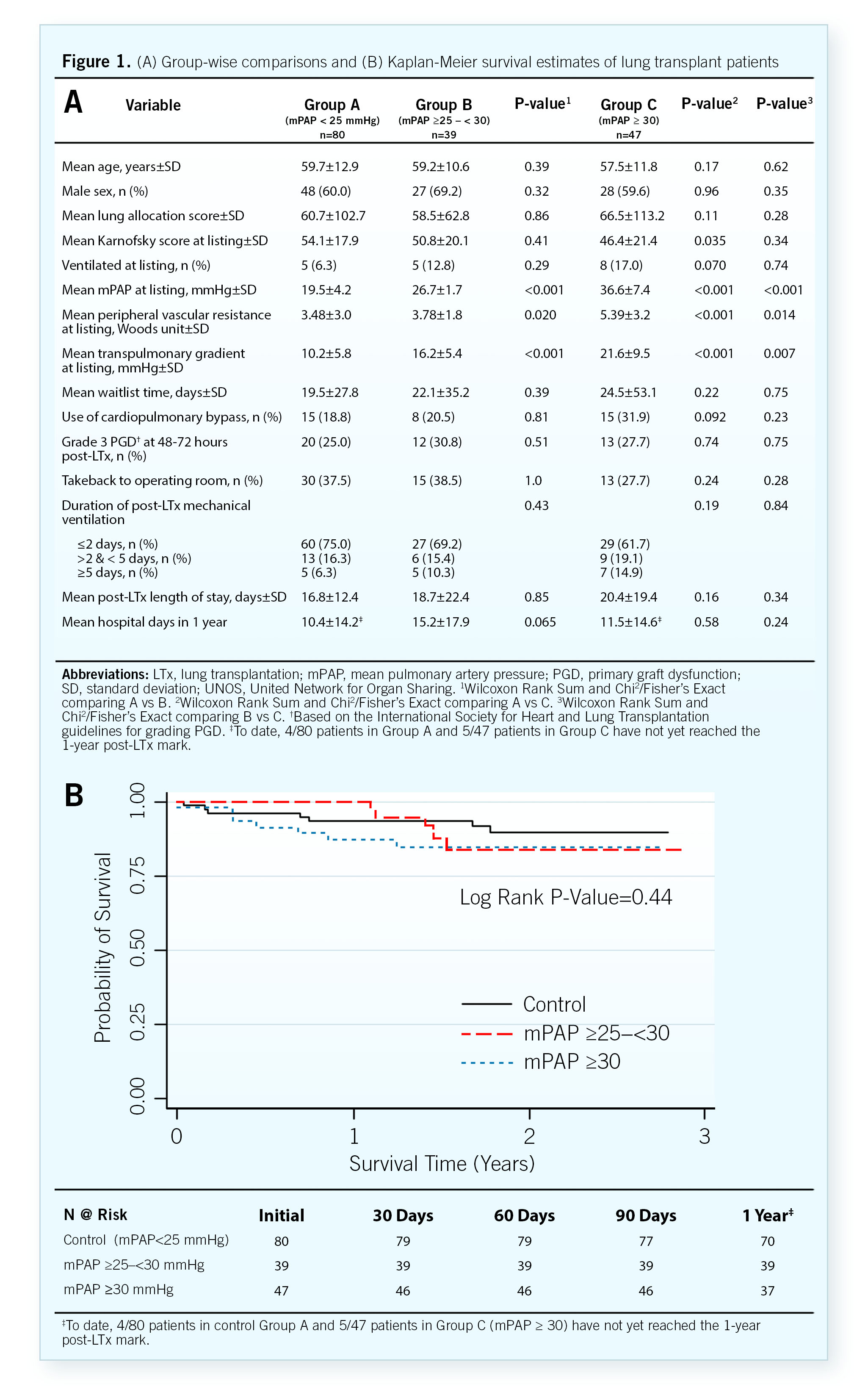Preoperative Pulmonary Hypertension Is Not Associated with Adverse Outcomes After Lung Transplantation.
1Norton Thoracic Institute, Phoenix
2Grand Canyon University, Phoenix
3University of Arizona, Phoenix
4St. Joseph's Hospital and Medical Center, Phoenix
Meeting: 2017 American Transplant Congress
Abstract number: B243
Keywords: Lung transplantation, Outcome, Pulmonary hypertension
Session Information
Session Name: Poster Session B: Lung Transplantation Poster Session
Session Type: Poster Session
Date: Sunday, April 30, 2017
Session Time: 6:00pm-7:00pm
 Presentation Time: 6:00pm-7:00pm
Presentation Time: 6:00pm-7:00pm
Location: Hall D1
Purpose: The effect of preoperative pulmonary hypertension (PH)[mdash]that is, mean pulmonary artery pressure (mPAP) of 25mmHg or higher[mdash]on lung transplantation (LTx) outcomes is debatable.
Methods: We reviewed the charts of patients undergoing LTx at our institution from 01/01/2014–12/31/2015. Patients were grouped based on mPAP at time of listing: (Group A: <25mmHg; Group B: ≥25 & <30mmHg; and Group C: ≥30mmHg). Pairwise comparisons were made and survival was estimated using Kaplan-Meier analysis. Values were deemed significant at p<0.05.
Results: In total, 166 patients underwent LTx during the study period, 160 (96%) of which were bilateral LTx. Of the 166 patients, 80 (48.2%) were in Group A, 39 (23.5%) in Group B, and 47 (28.3%) in Group C. The 3 groups were similar in terms of age, sex, and lung allocation score [Fig. 1] Patients in Group C had significantly lower functional status, were more likely to be ventilated at time of listing, and had higher cardiopulmonary bypass (CPB) usage than Group A. Rates of grade-3 primary graft dysfunction at 48-72 hours post-LTx were similar across groups (A: 25%; B: 30.7%; C: 27.7%). The 3 groups had comparable rates of takeback to operating room, post-LTx ventilator duration, and length of stay. 1-year post-LTx hospital days were similar across groups. 30-day, 90-day, and 1-year survival rates were also comparable across groups (A: 98.8%, 96%, and 93%; B: 100%, 100%, and 100%; C: 97.9%, 97.9%, and 88%, respectively; [Fig. 1] . A Cox Regression model showed comparable risk of death in Groups B and C as compared to Group A (p=0.9; Group B: HR 1.08, 95% CI [0.28, 4.21]; Group C: HR 1.05, 95% CI [0.98, 1.14]).
Conclusion: Although they tend to have higher rates of CPB usage, patients with PH pre-LTx have short-term outcomes comparable to those without pre-LTx PH, and can be safely listed for LTx.
CITATION INFORMATION: Biswas Roy S, Olson M, Harned D, Kang P, Panchanathan R, Hashimi A, Huang J, Abdelrazek H, Patel V, Omar A, Bremner R, Smith M, Walia R, Kalya A. Preoperative Pulmonary Hypertension Is Not Associated with Adverse Outcomes After Lung Transplantation. Am J Transplant. 2017;17 (suppl 3).
To cite this abstract in AMA style:
Roy SBiswas, Olson M, Harned D, Kang P, Panchanathan R, Hashimi A, Huang J, Abdelrazek H, Patel V, Omar A, Bremner R, Smith M, Walia R, Kalya A. Preoperative Pulmonary Hypertension Is Not Associated with Adverse Outcomes After Lung Transplantation. [abstract]. Am J Transplant. 2017; 17 (suppl 3). https://atcmeetingabstracts.com/abstract/preoperative-pulmonary-hypertension-is-not-associated-with-adverse-outcomes-after-lung-transplantation/. Accessed January 5, 2026.« Back to 2017 American Transplant Congress
